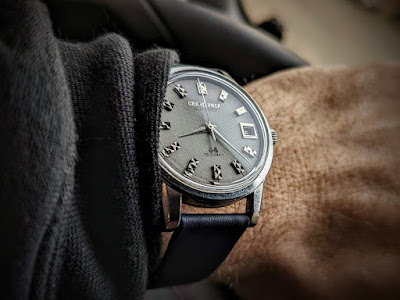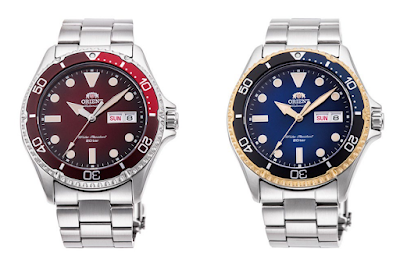There are many reasons to be fond of vintage watches. Words like "legacy", "history" and "tradition" often come to mind, along with clichés like "they don't make them like this anymore" and "watch industry today lost its soul".
The thing I like about Orient's old models is how wearable many of them
still are. Their robust, reliable movements keep ticking with minimal
maintenance, their looks are usually just as cool now as they were 40, 50 or
even 60 years ago, and many of them are quite sizeable – their divers from the
1960s and 70s in particular are more than 40mm wide and offer significant wrist
presence even by today's standards.
The Grand Prix "Almighty" 64 might not be such a beast diver,
but it nonetheless remained perfectly wearable; in fact, it is a wonderful
dress watch.
As promised at the end of my last blog post, discussing Orient's
Grand Prix line, today I'll be presenting my personal Grand Prix. It is a
fairly recent addition to my collection, acquired about three months ago.
The full name of this model would be "Orient Grand Prix Almighty 64
Triostat" but let's keep it short, and just call it GP 64. So what's this
GP 64 like in real life?
The GP 64 immediately stands out with its unique dial, which somehow
manages to be both glitzy and elegant. Most noticeable and eye-catching are its
multi-faceted hour markers. These are designed to capture light even in mostly
dark environments, enhancing the legibility of the watch – and in well-lit
spaces they really glitter and shine.
Complementing the lovely markers are curved and faceted dauphine hour
and minutes hands, and a purposefully-bent seconds hand. It is a high quality set
of hands, clearly designed to enhance legibility.
The dial itself is cleverly textured, appearing to change its color from
dark grey to a light shade that is almost like silver. Well, it probably is
silver. A close look at the dial shows it was both horizontally brushed and vertically
grooved, which probably adds to the complex way it interacts with light.
The LCW movement inside runs great, indeed it has been serviced by the
seller. It winds sweetly and maintains its power reserve well, and does not stray far from its original chronometric level of accuracy: it gained about 9 seconds in 24 hours, mostly while lying flat - it actually did not gain more than a second during 10 hours on the wrist. Service or not, this is really incredible for a watch that is nearly sixty
years old. Keep in mind, most of us would be happy with a vintage watch if it's
"within one minute per day"…
Speaking of winding the watch… it's funny that I assumed the crown was
not signed, but when taking macro shots of the watch for this story, I noticed
that the crown was actually signed! The logo was naturally eroded after decades
of use, but when examined closely it can still be seen.
Unlike some watch collectors, I try to avoid watches that I would not actually
wear – if not outdoors, then at least in the office. I do not keep "safe
queens". And indeed, the GP 64 is no exception.
Back when it was new, the practicality of this model was obvious: Its Pellaton
mechanism made sure it was efficiently wound; its time-keeping was accurate
thanks to the Triostat regulation; and it had proper shock absorption
thanks to Incabloc.
Nowadays, the GP 64's wearability is further enhanced by its dimensions.
At 38.5mm wide (without the crown) and 47mm long lug-to-lug, it hits the sweet
spot for dress watches. This is quite impressive, considering most dress
watches in the 1960s wear closer to 36mm.
The watch is about 13mm thick with its tall box crystal. If one was
looking for a slimmer watch, it would probably be possible to shave off a couple
of millimeters by replacing it with a flat crystal; but I find this quite
unnecessary. It looks great just the way it is.
It's easy to see why this watch was a flagship of the brand in its
youth; it is still a magnificent timepiece today. It functions just as good as
any modern dress watch – a lower power reserve being its only drawback against
current watches – while offering unique looks and, yes – soul.
Today, prices for a Grand Prix "Almighty" 64 vary greatly, and
I'm seeing items ranging from around 500 USD to more than 2,000 USD. Understandably,
there's no price-list for such a watch, and the asking price would be affected by elements
such as mechanical and external condition, and having an original case back and
an original bracelet.



















